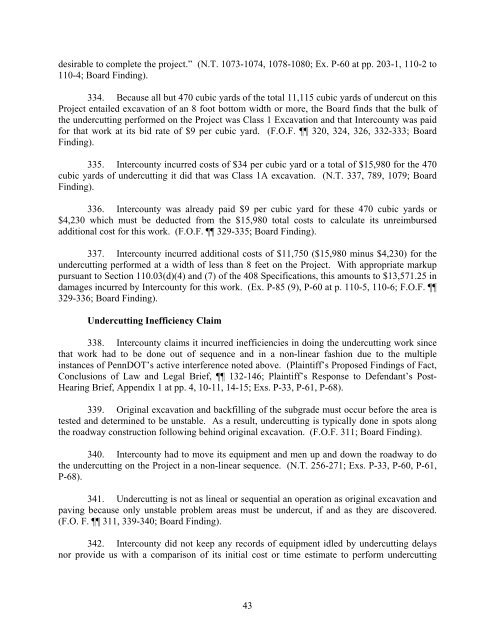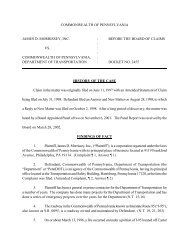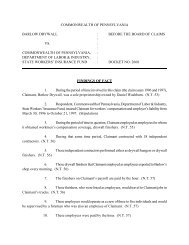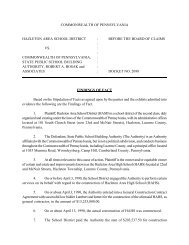3720 - Board of Claims
3720 - Board of Claims
3720 - Board of Claims
Create successful ePaper yourself
Turn your PDF publications into a flip-book with our unique Google optimized e-Paper software.
desirable to complete the project.” (N.T. 1073-1074, 1078-1080; Ex. P-60 at pp. 203-1, 110-2 to<br />
110-4; <strong>Board</strong> Finding).<br />
334. Because all but 470 cubic yards <strong>of</strong> the total 11,115 cubic yards <strong>of</strong> undercut on this<br />
Project entailed excavation <strong>of</strong> an 8 foot bottom width or more, the <strong>Board</strong> finds that the bulk <strong>of</strong><br />
the undercutting performed on the Project was Class 1 Excavation and that Intercounty was paid<br />
for that work at its bid rate <strong>of</strong> $9 per cubic yard. (F.O.F. 320, 324, 326, 332-333; <strong>Board</strong><br />
Finding).<br />
335. Intercounty incurred costs <strong>of</strong> $34 per cubic yard or a total <strong>of</strong> $15,980 for the 470<br />
cubic yards <strong>of</strong> undercutting it did that was Class 1A excavation. (N.T. 337, 789, 1079; <strong>Board</strong><br />
Finding).<br />
336. Intercounty was already paid $9 per cubic yard for these 470 cubic yards or<br />
$4,230 which must be deducted from the $15,980 total costs to calculate its unreimbursed<br />
additional cost for this work. (F.O.F. 329-335; <strong>Board</strong> Finding).<br />
337. Intercounty incurred additional costs <strong>of</strong> $11,750 ($15,980 minus $4,230) for the<br />
undercutting performed at a width <strong>of</strong> less than 8 feet on the Project. With appropriate markup<br />
pursuant to Section 110.03(d)(4) and (7) <strong>of</strong> the 408 Specifications, this amounts to $13,571.25 in<br />
damages incurred by Intercounty for this work. (Ex. P-85 (9), P-60 at p. 110-5, 110-6; F.O.F. <br />
329-336; <strong>Board</strong> Finding).<br />
Undercutting Inefficiency Claim<br />
338. Intercounty claims it incurred inefficiencies in doing the undercutting work since<br />
that work had to be done out <strong>of</strong> sequence and in a non-linear fashion due to the multiple<br />
instances <strong>of</strong> PennDOT’s active interference noted above. (Plaintiff’s Proposed Findings <strong>of</strong> Fact,<br />
Conclusions <strong>of</strong> Law and Legal Brief, 132-146; Plaintiff’s Response to Defendant’s Post-<br />
Hearing Brief, Appendix 1 at pp. 4, 10-11, 14-15; Exs. P-33, P-61, P-68).<br />
339. Original excavation and backfilling <strong>of</strong> the subgrade must occur before the area is<br />
tested and determined to be unstable. As a result, undercutting is typically done in spots along<br />
the roadway construction following behind original excavation. (F.O.F. 311; <strong>Board</strong> Finding).<br />
340. Intercounty had to move its equipment and men up and down the roadway to do<br />
the undercutting on the Project in a non-linear sequence. (N.T. 256-271; Exs. P-33, P-60, P-61,<br />
P-68).<br />
341. Undercutting is not as lineal or sequential an operation as original excavation and<br />
paving because only unstable problem areas must be undercut, if and as they are discovered.<br />
(F.O. F. 311, 339-340; <strong>Board</strong> Finding).<br />
342. Intercounty did not keep any records <strong>of</strong> equipment idled by undercutting delays<br />
nor provide us with a comparison <strong>of</strong> its initial cost or time estimate to perform undercutting<br />
43






